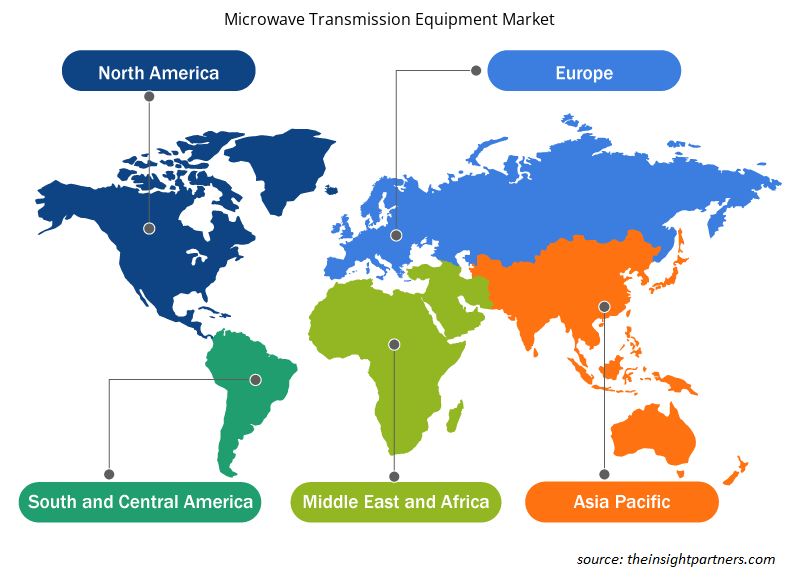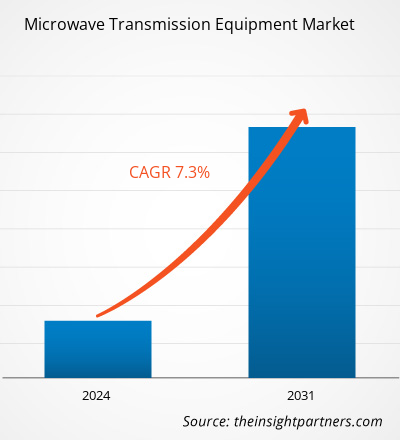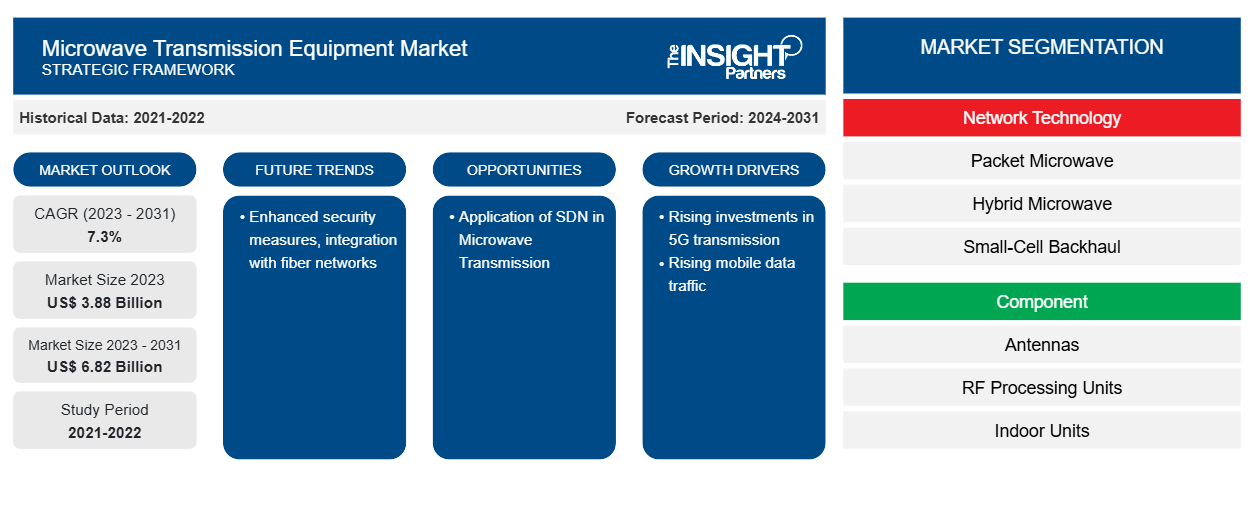Si prevede che la dimensione del mercato delle apparecchiature di trasmissione a microonde raggiungerà i 6,82 miliardi di dollari entro il 2031, rispetto ai 3,88 miliardi di dollari del 2023. Si prevede che il mercato registrerà un CAGR del 7,3% nel periodo 2023-2031. È probabile che misure di sicurezza migliorate e l'integrazione con le reti in fibra rimangano una tendenza chiave nel mercato.
Analisi di mercato delle apparecchiature di trasmissione a microonde
Le microonde sono una tecnica di comunicazione wireless a linea di vista che consente connessioni wireless ad alta velocità con la possibilità di inviare e ricevere dati, video e telefonate utilizzando fasci di onde radio ad alta frequenza. Le comunicazioni radio nello spazio profondo, le comunicazioni satellitari e i sistemi di comunicazione punto a punto sulla Terra utilizzano tutti frequentemente la trasmissione radio a microonde. I radar, i sistemi di radionavigazione, i sistemi di sensori e la radioastronomia utilizzano altre porzioni della gamma radio a microonde.
Panoramica del mercato delle apparecchiature di trasmissione a microonde
I fornitori di servizi sono costretti ad aumentare la loro capacità di backhaul mobile utilizzando sia tecnologie in fibra/rame che wireless a causa della crescita esplosiva del traffico dati mobile guidato da 4G e 5G. Gli investimenti nell'infrastruttura 5G stanno guadagnando slancio a livello globale. Inoltre, il traffico dati è in aumento; ciò richiede lo sviluppo di soluzioni di backhaul che coinvolgano apparecchiature di trasmissione a microonde. Ciò sta guidando la crescita del mercato.
Personalizza questo report in base alle tue esigenze
Riceverai la personalizzazione gratuita di qualsiasi report, comprese parti di questo report, o analisi a livello nazionale, pacchetto dati Excel, oltre a usufruire di grandi offerte e sconti per start-up e università
-
Scopri le principali tendenze di mercato in questo rapporto.Questo campione GRATUITO includerà analisi di dati che spaziano dalle tendenze di mercato alle stime e alle previsioni.
Driver e opportunità del mercato delle apparecchiature di trasmissione a microonde
Crescenti investimenti nella trasmissione 5G per favorire il mercato
Il 5G mira a dare agli utenti accesso a più di 100 Mbps ovunque, in qualsiasi momento. Le larghezze di banda medie e di picco di una stazione base 5G saranno dieci volte superiori a quelle delle reti 4G, arrivando rispettivamente a oltre 1 Gbps e 10 Gbps. L'avanzamento delle tecnologie a microonde ha portato a un aumento della larghezza di banda a microonde da Mbps a Gbps. La larghezza di banda a microonde consentirà 10 Gbps man mano che vengono introdotte tecnologie più innovative, tra cui multiple-input multiple-output (MIMO), carrier aggregation (CA), banda E a grande capacità e combinazione di banda comune con banda E. Ciò coprirà completamente i requisiti di larghezza di banda per il cuscinetto 5G. Sono stati installati oltre due milioni di dispositivi a microonde in tutto il mondo. Nell'era del 5G, i microonde devono sfruttare al meglio le loro apparecchiature esistenti sostituendo minimamente le parti (come schede e ODU). Oltre a salvaguardare l'investimento iniziale degli operatori, ciò accelera lo sviluppo del 5G.
Applicazione di SDN nella trasmissione a microonde
A dicembre 2021, Ericsson e Telefónica Germania/O2 hanno compiuto un significativo passo avanti nell'implementazione e nella gestione del software-defined networking (SDN) per le reti a microonde. Per consentire al fornitore di servizi di comunicazione (CSP) di implementare un'interfaccia SDN indipendente dal fornitore nella propria rete nazionale O2, Ericsson ha abilitato il proprio portafoglio di prodotti a microonde MINI-LINK nella rete O2. Pertanto, sul mercato ci sono opportunità per i fornitori di servizi di migliorare la flessibilità e la scalabilità della rete utilizzando SDN nella trasmissione a microonde.
Analisi della segmentazione del rapporto di mercato delle apparecchiature di trasmissione a microonde
I segmenti chiave che hanno contribuito alla derivazione dell'analisi di mercato delle apparecchiature di trasmissione a microonde sono la tecnologia di rete, i componenti, la banda di frequenza, il tipo di montaggio e l'applicazione.
- In base alla tecnologia di rete, il mercato delle apparecchiature di trasmissione a microonde è suddiviso in packet microwave, hybrid microwave, small-cell backhaul e time division multiplexing. Il segmento packet microwave ha detenuto la quota maggiore nel 2023.
- In base ai componenti, il mercato è suddiviso in antenne, unità di elaborazione RF, unità interne (IDU), unità esterne (ODU) e cavi e connettori.
- In base alla banda di frequenza, il mercato è suddiviso in banda L, banda S, banda C, banda X, banda Ku, banda Ka, banda Q e altre.
- In base al tipo di montaggio, il mercato si divide in completamente da interno, completamente da esterno e completamente da esterno.
- In base all'applicazione, il mercato è suddiviso in navigazione, comunicazione cellulare, telecomunicazioni radio, comunicazione satellitare, radar e comunicazione a banda larga.
Analisi della quota di mercato delle apparecchiature di trasmissione a microonde per area geografica
L'ambito geografico del rapporto sul mercato delle apparecchiature di trasmissione a microonde è suddiviso principalmente in cinque regioni: Nord America, Asia Pacifico, Europa, Medio Oriente e Africa, Sud e Centro America.
Il Nord America detiene una quota significativa del mercato delle apparecchiature di trasmissione a microonde nel 2023. La regione ha un gran numero di progetti di lancio 5G che supportano la domanda di apparecchiature di trasmissione a microonde. Il supporto e le iniziative governative nella regione stanno fortemente supportando la trasformazione digitale nell'infrastruttura di comunicazione, guidando così la crescita del mercato nella regione.
Approfondimenti regionali sul mercato delle apparecchiature di trasmissione a microonde
Le tendenze regionali e i fattori che influenzano il mercato delle apparecchiature di trasmissione a microonde durante il periodo di previsione sono stati ampiamente spiegati dagli analisti di Insight Partners. Questa sezione discute anche i segmenti e la geografia del mercato delle apparecchiature di trasmissione a microonde in Nord America, Europa, Asia Pacifico, Medio Oriente e Africa e America meridionale e centrale.

- Ottieni i dati specifici regionali per il mercato delle apparecchiature di trasmissione a microonde
Ambito del rapporto di mercato sulle apparecchiature di trasmissione a microonde
| Attributo del report | Dettagli |
|---|---|
| Dimensioni del mercato nel 2023 | 3,88 miliardi di dollari USA |
| Dimensioni del mercato entro il 2031 | 6,82 miliardi di dollari USA |
| CAGR globale (2023-2031) | 7,3% |
| Dati storici | 2021-2022 |
| Periodo di previsione | 2024-2031 |
| Segmenti coperti |
Per tecnologia di rete
|
| Regioni e Paesi coperti |
America del Nord
|
| Leader di mercato e profili aziendali chiave |
|
Densità degli attori del mercato delle apparecchiature di trasmissione a microonde: comprendere il suo impatto sulle dinamiche aziendali
Il mercato delle apparecchiature di trasmissione a microonde sta crescendo rapidamente, spinto dalla crescente domanda degli utenti finali dovuta a fattori quali l'evoluzione delle preferenze dei consumatori, i progressi tecnologici e una maggiore consapevolezza dei vantaggi del prodotto. Con l'aumento della domanda, le aziende stanno ampliando le loro offerte, innovando per soddisfare le esigenze dei consumatori e capitalizzando sulle tendenze emergenti, il che alimenta ulteriormente la crescita del mercato.
La densità degli operatori di mercato si riferisce alla distribuzione di aziende o società che operano in un particolare mercato o settore. Indica quanti concorrenti (operatori di mercato) sono presenti in un dato spazio di mercato in relazione alle sue dimensioni o al valore di mercato totale.
Le principali aziende che operano nel mercato delle apparecchiature di trasmissione a microonde sono:
- Società NEC
- Società controllata da Huawei
- Telefonaktiebolaget LM Ericsson
- Gruppo SIAE MICROELETTRONICA
- Telecomunicazioni Intracom
- Società Nokia
Disclaimer : le aziende elencate sopra non sono classificate secondo un ordine particolare.

- Ottieni una panoramica dei principali attori del mercato delle apparecchiature di trasmissione a microonde
Notizie e sviluppi recenti sul mercato delle apparecchiature di trasmissione a microonde
Il mercato delle apparecchiature di trasmissione a microonde viene valutato raccogliendo dati qualitativi e quantitativi dopo la ricerca primaria e secondaria, che include importanti pubblicazioni aziendali, dati associativi e database. Di seguito sono elencati alcuni degli sviluppi nel mercato delle apparecchiature di trasmissione a microonde:
- NEC Corporation (NEC; TSE: 6701) ha annunciato oggi di aver stipulato un accordo definitivo con Aviat Networks, Inc. (Aviat; Nasdaq: AVNW), il principale esperto in soluzioni di trasporto e accesso wireless, per integrare la sua attività di trasporto wireless con quella di Aviat in una transazione di acquisto di asset del valore di 70,0 milioni di dollari USA in contanti e azioni. (Fonte: NEC Corporation, comunicato stampa, maggio 2023)
- Huawei ha lanciato la sua nuova generazione di microonde MAGICSwave al Mobile World Congress (MWC) 2023 di Barcellona. MAGICSwave utilizza innovazioni intergenerazionali per aiutare gli operatori a creare reti target semplificate che siano meglio orientate all'evoluzione 5G a lungo termine, poiché ottimizzano il costo totale di proprietà (TCO) e l'evoluzione fluida della rete di trasporto. (Fonte: Huawei Technologies Co., Ltd., comunicato stampa, marzo 2023)
Copertura e risultati del rapporto sul mercato delle apparecchiature di trasmissione a microonde
Il rapporto "Dimensioni e previsioni del mercato delle apparecchiature di trasmissione a microonde (2021-2031)" fornisce un'analisi dettagliata del mercato che copre le seguenti aree:
- Dimensioni e previsioni del mercato delle apparecchiature di trasmissione a microonde a livello globale, regionale e nazionale per tutti i principali segmenti di mercato coperti dall'ambito
- Tendenze del mercato delle apparecchiature di trasmissione a microonde, nonché dinamiche di mercato quali driver, vincoli e opportunità chiave
- Analisi dettagliata delle cinque forze PEST/Porter e SWOT
- Analisi di mercato delle apparecchiature di trasmissione a microonde che copre le principali tendenze del mercato, il quadro globale e regionale, i principali attori, le normative e i recenti sviluppi del mercato
- Analisi del panorama industriale e della concorrenza che copre la concentrazione del mercato, l'analisi della mappa di calore, i principali attori e gli sviluppi recenti nel mercato delle apparecchiature di trasmissione a microonde
- Profili aziendali dettagliati
- Analisi storica (2 anni), anno base, previsione (7 anni) con CAGR
- Analisi PEST e SWOT
- Valore/volume delle dimensioni del mercato - Globale, Regionale, Nazionale
- Industria e panorama competitivo
- Set di dati Excel
Report recenti
Testimonianze
Motivo dell'acquisto
- Processo decisionale informato
- Comprensione delle dinamiche di mercato
- Analisi competitiva
- Analisi dei clienti
- Previsioni di mercato
- Mitigazione del rischio
- Pianificazione strategica
- Giustificazione degli investimenti
- Identificazione dei mercati emergenti
- Miglioramento delle strategie di marketing
- Aumento dell'efficienza operativa
- Allineamento alle tendenze normative























 Ottieni un campione gratuito per - Mercato delle apparecchiature di trasmissione a microonde
Ottieni un campione gratuito per - Mercato delle apparecchiature di trasmissione a microonde